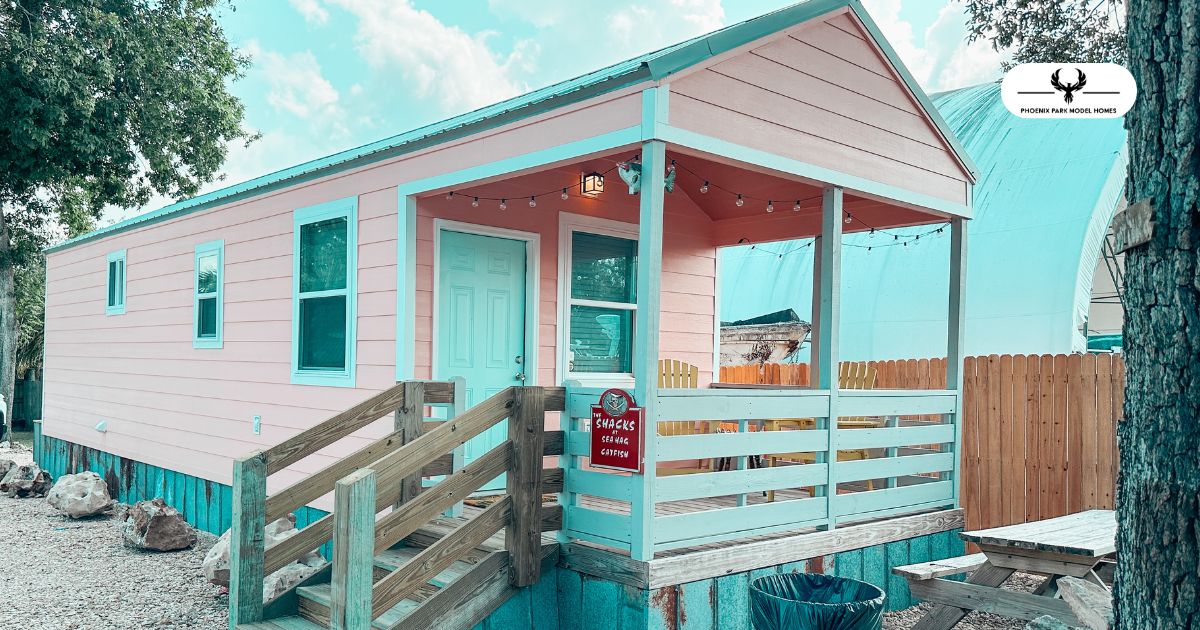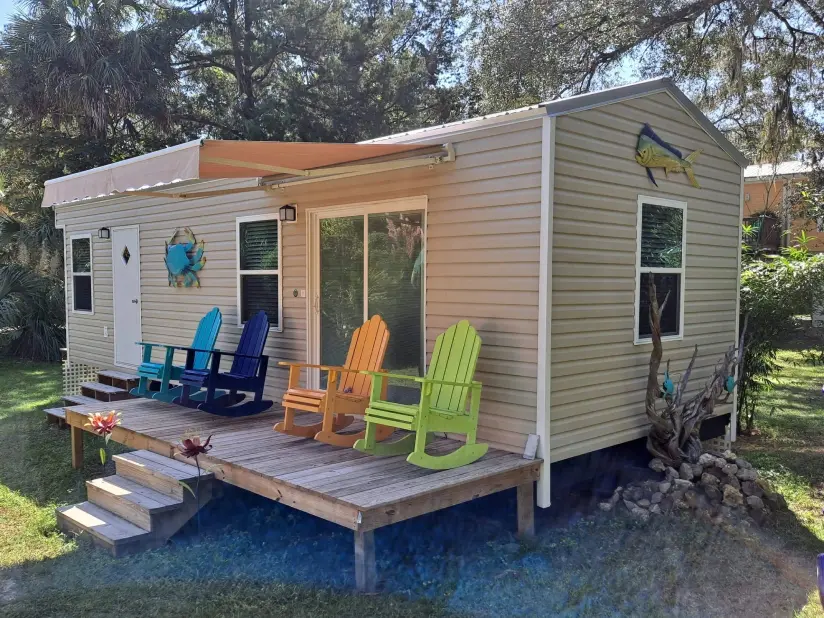In the picturesque neighborhood you live in, you notice a trend of minimalist living taking root. Two distinct types of homes are catching everyone’s attention. These are Park Models and Tiny Homes.
With their unique charm and efficient designs, these compact dwellings are a testament to innovative architecture and a growing desire to lead affordable, sustainable lives.
With payment bills piling up and you considering mortgaging your house, you wonder what the fuss is all about. As more and more people are looking to downsize and embrace simplicity, the choice between park model homes and tiny homes becomes a fascinating deliberation to you.
Hopefully, you will come across our page and stay on as we explain and compare park model homes and tiny homes to help you decide which is best for your lifestyle.
| Aspect | Park Model Homes | Tiny Homes |
|---|---|---|
| Size & Design |
|
|
| Intended Use | Perfect for longer stays, getaways, or as a serene retreat away from the urban hustle | Designed primarily for those seeking a minimalist full-time residence |
| Mobility |
|
|
| Regulations & Codes | Comply with ANSI A119.5 RV standards. | Has no Regulations |
| Aesthetics | Elegant designs leaning towards a classic cabin or cottage aesthetic with modern amenities | Varying designs, from modern to rustic, depending on customization |
| Financing Options | Straightforward financing similar to an RV, often with competitive loan terms | Can vary significantly, sometimes more complex due to their diverse classification |
| Benefits | Offers the comforts of home, affordability, and the beauty of a vacation spot all year round | Smaller footprint, energy-efficient designs and adaptability |
| Drawbacks | Certain customization restrictions due to standardized construction | Potential legal challenges due to zoning and regulations; limited space |
| Price Range | Typically more cost-effective with standardized features ensuring value for money | Depending on customization, can sometimes be pricier |
| Resale Value | Tend to retain value especially when located in popular or scenic spots | Resale values can be unpredictable, depending on build quality and design |
For a swift understanding, we’ve outlined the primary differences between Park Model Homes and Tiny Homes in the table above. If you wish for a more detailed exploration, please continue with the rest of our blog.
What are Park Model Homes?
Park Model Homes are specific recreational vehicles (RV) for temporary accommodation. Unlike traditional RVs, they resemble small houses. They are often placed in vacation destinations like RV parks, lakes, or campgrounds. While they can be transported, they are typically set in one place for extended periods. These homes bridge the gap between mobile RVs and traditional stationary homes.

Full House 2 series- Phoenix Park models
What is the History of Park Model Homes?
Park Model Homes emerged as an evolution of the traditional RV. As vacationers sought more comfortable and home-like accommodations for their extended stays, the RV industry responded with a design emphasizing aesthetics and residential features. Originating in the late 20th century, these homes quickly gained popularity, becoming essential to many RV parks and vacation spots nationwide.
What are the Features of Park Model Homes?
Typically under 400 square feet, Park Model Homes are small, portable living spaces that adhere to the size regulations for recreational vehicles.
Park model homes are built to ANSI code (RV) and are generally single-story structures with one bedroom and one bathroom. Their design leans towards a cabin or cottage aesthetic, often featuring modern amenities and home-like interiors. They are intended for temporary or seasonal use and are especially popular among retirees or those looking for vacation homes.
What are the Benefits and Drawbacks of Owning a Park Model Home?
Benefits:
One of the primary benefits of a park model home is its affordability and portability. Compared to traditional homes or even some RVs, park models are cost-effective.
Additionally, while they are designed to be stationary for extended periods, they retain portability. This would allow owners to move them from one location to another with relative ease, though not as frequently as one would with a regular RV.
Drawbacks:
However, there are also drawbacks to owning a park model home. They are limited in space and lack customization options, making them feel cramped and less comfortable than traditional homes.
Due to their compact nature, park model homes offer limited space, which can challenge those not accustomed to a minimalist lifestyle. Additionally, while various designs are available, there might be restrictions on customization due to their standardized construction and adherence to RV regulations. Additionally, park model homes are not intended to be used as full-time residences, which can limit their appeal for some people.
What are Tiny Homes?
Tiny homes are small living spaces that are typically under 1000 square feet. They are designed to be used as full-time residences and are often built on a permanent foundation. Tiny homes come in various designs and styles, and many are made to be energy-efficient and sustainable.
Tiny homes are small living spaces that challenge traditional notions of what a home should be. These little homes, typically between 100 and 400 square feet, emphasize simplicity, sustainability, and practical design.

The Phoenix tiny home
What is the History of Tiny Homes?
The tiny home movement can trace its roots back to the 1970s. Still, it gained significant traction in the early 2000s, especially after the 2008 financial crisis. As people sought more financially sustainable living options and a reduced environmental footprint, the allure of tiny living grew stronger.
What are the Benefits and Drawbacks of Tiny Homes?
Benefits:
Tiny homes offer a unique combination of size, design, and flexibility. Their compact nature encourages efficient and innovative design solutions. They are often less expensive than traditional homes and can be built using eco-friendly materials and technologies. Additionally, tiny homes are designed to be energy-efficient, which can help reduce utility costs.
Moreover, they cater to people seeking a minimalist lifestyle, wishing to reduce their environmental impact, or hoping to achieve housing independence from mortgages and rents.
Drawbacks:
Like park model homes, the limited space can be challenging in tiny homes. Moreover, one of the most significant issues tiny homeowners face is the lack of legal recognition. Zoning laws, building codes, and land-use regulations often don’t accommodate or recognize tiny homes, leading to legal challenges for residents.
This indicates that tiny homes may not be suitable for people with large families or those who require more space for work or hobbies.
What is the Aesthetic Difference Between Park Model Homes and Tiny Homes?
While park model homes and tiny homes are similar in many ways, significant differences are important to know about. The main difference between park model homes and tiny homes is the regulations, codes, and specifications used to build them and their intended use.
With both compact living solutions, park model homes often lean towards vacation or seasonal homes and adhere strictly to the RV size regulations. In contrast, tiny homes are more diverse in their design, often built with the intent of full-time living and pushing the boundaries of innovative space usage.
Additionally, park model homes are generally smaller than tiny homes and have fewer customization options. They are often designed to be energy-efficient and portable, making them a good choice for people who want to downsize and simplify their lives. On the other hand, small homes may be tailored to the owner’s needs and are available in a variety of forms and types.
What are the Regulatory Differences Between Park Model Homes and Tiny Homes?
Park model homes generally adhere to RV industry regulations, given their classification as recreational vehicles. Tiny homes, on the other hand, navigate a gray area. Depending on how they are built and where they are located, they might adhere to local building codes or RV regulations. This ambiguity often leads to challenges in legal recognition and placement.
People should consider their location when choosing between a park model home and a tiny home. By considering their area’s zoning laws and regulations, they can make a calculated choice before choosing between a park model home and a tiny home.
What are the Differences in Financing Options Available for Park Model Homes and Tiny Homes?
Financing a park model home can be akin to funding an RV with similar loan terms and interest rates. Tiny homes, however, can be more challenging due to their diverse classification. Depending on the home’s specifications and placement, they might be financed as personal loans, RV loans, or even traditional mortgages.
Besides, people should consider their budget when choosing between a park model home and a tiny home. Park model homes are often less expensive than tiny homes. Still, they may offer less space or customization options. Tiny homes, on the other hand, can be more costly but provide more space and customization options.
What Factors Should I Consider When Choosing Between a Park Model and a Tiny Home?
When choosing between a park model home and a tiny home, several factors must be considered. These include lifestyle, budget, and location.
A park model might be more fitting if you desire a vacation home or seasonal retreat. If you’re looking for a full-time residence with a minimalist ethos, a tiny home could be your choice. Budget-wise, both can be affordable but remember to factor in costs like land or RV park fees. Lastly, consider the location. Zoning laws and building codes can dictate where you can legally place your dwelling, so research local regulations before deciding.
Conclusion
In conclusion, park model homes and tiny homes are two types of small living spaces that offer affordable and sustainable living options. While they are similar in many ways, significant differences are important to know about. When choosing between a park model home and a tiny home, people should consider their lifestyle, budget, and location. By considering these factors, people can decide which type of small living space is right for them.
At Phoenix Park Model Homes, we believe in merging elegance with functionality. Experience the pinnacle of compact living without compromising on style or comfort. As you embrace a simpler lifestyle, let us be your guide to unparalleled craftsmanship and design. Join the Phoenix community today and redefine your living experience.
FAQs
1. What Are the Main Differences Between Park Model Homes and Tiny Homes?
Size and Design: Park model homes typically stick to a size under 400 sq. ft. to fit RV industry regulations. They often resemble small houses and are used in vacation spots. Tiny homes, on the other hand, range from 100 to 400 sq. ft., and their designs can be more diverse.
Intended Use: Park model homes are usually intended for seasonal or vacation use, while tiny homes are designed for full-time living.
Mobility: While both can be moved, park models are generally more stationary, and tiny homes are built to be more mobile.
2. Is it better to build a tiny house or buy an RV?
It depends on your needs. If you value customization, a unique design, and a homely feel, a tiny house might be more suitable. However, if mobility and the ability to easily travel are top priorities, an RV may be the better choice.
3. Which Is More Cost-Effective: A Park Model Home or a Tiny Home?
Initial costs for both can be similar, but other factors like customization, location (land costs or RV park fees), and maintenance can vary. Tiny homes can sometimes be built more affordably if done DIY, while park model homes, when purchased new from manufacturers, might have higher costs.
4. How Does Resale Value Compare?
Resale values can fluctuate based on various factors. Generally, well-maintained park model homes in desirable locations might retain value better. Tiny homes, being a newer concept and highly customizable, might see a wider variance in resale values based on build quality, materials, and design.
5. What is considered a tiny house?
Tiny houses vary in size and mobility. Those designed for mobility are usually below 400 square feet, while those on permanent foundations might be under 1000 square feet. However, there’s no set standard for what defines a tiny house.
6. What qualifies a Park Home model and a Tiny home?
Park Model Homes: Typically, these adhere to the Recreational Vehicle Industry Association’s guidelines, staying under 400 sq. ft., and are designed for temporary accommodation or recreational use.
Tiny Homes: Their qualifications can vary. While many fall under the 400 sq. ft. threshold, the primary focus is on maximizing a small space for full-time living. Zoning laws, building codes, and the location can play significant roles in their qualifications.












